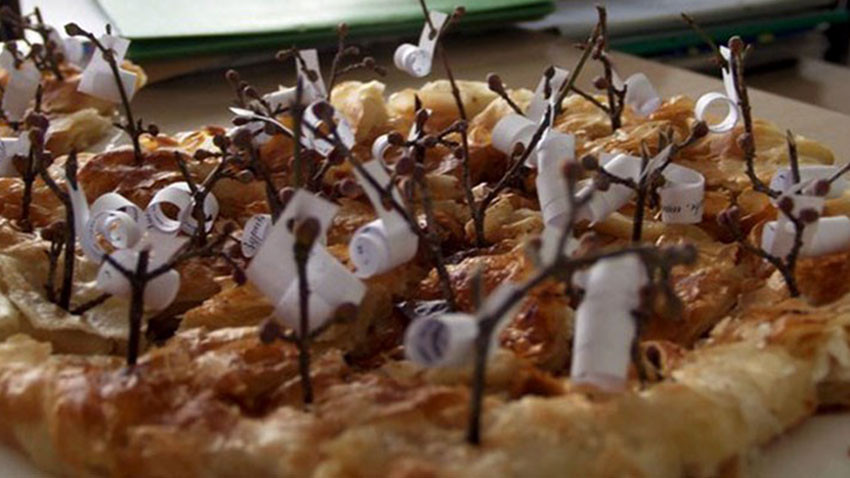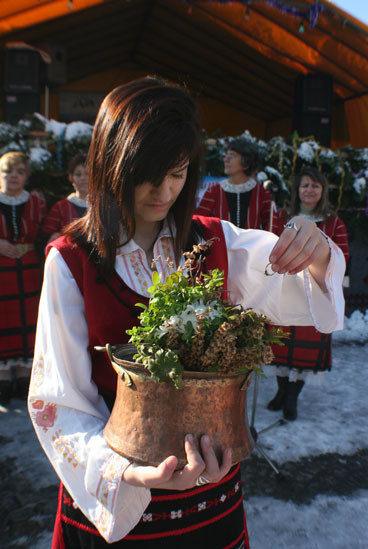Surva, Survaki or Vassilyovden (St. Basil’s Day) are the Bulgarian words that can be heard most often on the first day of the New Year. January 1 is celebrated across Bulgaria as well as by ethnic Bulgarians living abroad.
The Surva Eve meal is the second thurified dinner after Christmas Eve and to a great extent mirrors its ritual elements. The decoration on the ritual loaves is the same, as is the symbolic meaning it conveys. But the main difference is that the food eaten includes meat and dairy products. By a tradition a round loaf, mlin (a kind of banitsa) and a pig’s head on the eve of January 1 are thurified. In some parts of Bulgaria, a round bun is placed on top of the loaf. Once the food is thurified, the bun is taken away and parts of it are given to the domestic animals in the morning; the rest is kept for medicinal purposes.
In different parts of the country different kinds of bakery products are made – mlin, banitsa, bulgurnik, zelnik – different varieties of baked filo pastry with a different filling – eggs with cheese, cabbage, grits. Mlin or banitsa is made out of filo pastry, eggs and fat. Tutmanik is a bit different – dough is kneaded, then divided into two or three parts which are then made into round loaves, again with egg and cheese filling in between. Banitsa recipes may be different for the different parts of the country, but one thing is the same wherever you may go - cornel-tree twigs are placed inside, each one representing the things we want to wish our loved ones – good luck, health, success in their work or in their studies… This is the kind of banitsa we in Bulgaria bake to this day, though we usually buy ready rolled pastry. And we write the good-luck wishes on bits of paper which we wrap around the cornel twigs.

On this night the pig’s head is a must. Cooked whole, following the recipe typical of the region, the festive meal would revolve around it. It is the only ritual in Bulgarian tradition when pork is deemed ritual food and is thurified. Just as on Christmas Eve, walnuts, whole garlic and onion bulbs and honey are also placed on the table. In some villages there would be horo dancing through the night – for health and a rich harvest.

In some parts of the country, the onion bulb would be cut up into twelve rings and thurified – for each month of the year. The rings would be placed on the table with salt in the middle; come morning the way the salt had melted and water had gathered would be used to divine the future – for example if there was water inside the onion ring that meant the month it represents would be rainy.
 The magic of the first day of the year – called initiation magic – explains all beliefs connected with Surva. The first guest to have stepped over the threshold of the house would be an indication of the kind of year that was starting. If it was a boy, there would be more male lambs, if it was a girl – more female lambs. A symbol of health, strength and youth, the cornel-tree plays a special role in traditional rituals. It is used to make survachki – the decorated cornel twigs used by boys aged 12 – 15 when they made their rounds of the houses in the village to tap people on the back wishing them good luck and prosperity. These boys, called survakari, would carry a bag over their shoulder to put the gifts they received in. The lads would first tap the backs of their relatives (survakane), chanting blessings for health and fertility. They would begin with the oldest member of the household and would end with the… animals. In Western Bulgaria the survakane by masked groups of young unmarried lads is reminiscent of the spring tradition of the kukeri or mummers, practiced in the Eastern part of the country.
The magic of the first day of the year – called initiation magic – explains all beliefs connected with Surva. The first guest to have stepped over the threshold of the house would be an indication of the kind of year that was starting. If it was a boy, there would be more male lambs, if it was a girl – more female lambs. A symbol of health, strength and youth, the cornel-tree plays a special role in traditional rituals. It is used to make survachki – the decorated cornel twigs used by boys aged 12 – 15 when they made their rounds of the houses in the village to tap people on the back wishing them good luck and prosperity. These boys, called survakari, would carry a bag over their shoulder to put the gifts they received in. The lads would first tap the backs of their relatives (survakane), chanting blessings for health and fertility. They would begin with the oldest member of the household and would end with the… animals. In Western Bulgaria the survakane by masked groups of young unmarried lads is reminiscent of the spring tradition of the kukeri or mummers, practiced in the Eastern part of the country.
 In the Bulgarian Orthodox church calendar January 1 is the day dedicated to St. Basil the Great or known as Vassilyovden in popular tradition. On the eve of the New Year unmarried girls perform a ritual called laduvane - they first go to fetch “silent water” i.e. water brought from the well in complete silence. The girl who fetches it must have living parents and the container she carries it in must be white. In this utensil the girls would drop their rings or nosegays, tied together with different coloured thread so they can recognize them later. The runt – i.e. the last child in the family would then take the rings out one by one. And each time the girls would chant verses that would reveal what kind of young man the ring’s owner would marry. Then they would drop their rings into the crock again, throw a red piece of cloth over it and leave it under a rose bush. After the rings had been left overnight under the starry skies, the ritual would be repeated. The texts of the songs describing what the future husband would be like take the form of riddles, studded with symbols, jocular and witty.
In the Bulgarian Orthodox church calendar January 1 is the day dedicated to St. Basil the Great or known as Vassilyovden in popular tradition. On the eve of the New Year unmarried girls perform a ritual called laduvane - they first go to fetch “silent water” i.e. water brought from the well in complete silence. The girl who fetches it must have living parents and the container she carries it in must be white. In this utensil the girls would drop their rings or nosegays, tied together with different coloured thread so they can recognize them later. The runt – i.e. the last child in the family would then take the rings out one by one. And each time the girls would chant verses that would reveal what kind of young man the ring’s owner would marry. Then they would drop their rings into the crock again, throw a red piece of cloth over it and leave it under a rose bush. After the rings had been left overnight under the starry skies, the ritual would be repeated. The texts of the songs describing what the future husband would be like take the form of riddles, studded with symbols, jocular and witty.
Best wishes for a happy, prosperous and successful New Year to all!
The Bulgarian National Radio hosted the annual Public Broadcasters International (PBI) Conference for the first time. Heads and representatives of public radio and television stations from 24 countries participated, including UK, France, Spain, the USA,..
Long-distance sailing captain Svetlozar Tenev has set off from the port city of Varna on Bulgaria's northern Black Sea coast on a circumnavigation of the world . His route will begin in Las Palmas (Canary Islands , Spain), where the man will..
A meeting titled “Mission Water” is taking place today at Burgas State University “Prof. Dr Assen Zlatarov”. The event gathers researchers involved in the European Union’s Mission “Restore Our Ocean and Waters” under the European Commission,..
How to preserve and maintain public trust in media - this is the central topic for participants in the Public Broadcasters..
Long-distance sailing captain Svetlozar Tenev has set off from the port city of Varna on Bulgaria's northern Black Sea coast on a circumnavigation of the..
A meeting titled “Mission Water” is taking place today at Burgas State University “Prof. Dr Assen Zlatarov”. The event gathers researchers involved..

+359 2 9336 661
